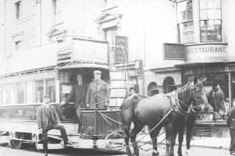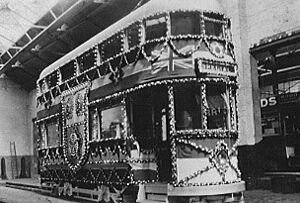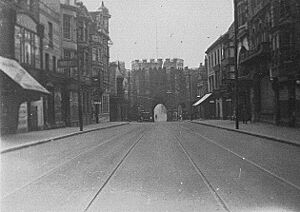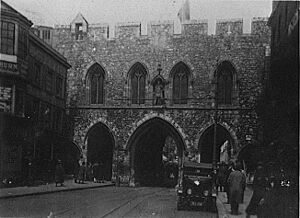Southampton Corporation Tramways facts for kids
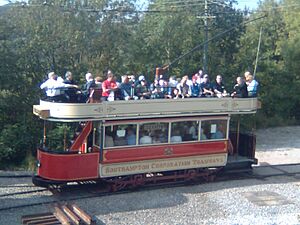
The Southampton Corporation Tramways was a company that ran public transport in Southampton. It started in 1879 and closed in 1949. At first, the trams were pulled by horses. Later, they were powered by electricity.
Contents
Why Southampton Needed Trams
Southampton, a city in the United Kingdom located in Hampshire, was growing fast in the 1800s. In 1841, about 27,000 people lived there. This was because the city's docks were becoming very busy.
A railway also opened in 1839. Soon after, a horse-drawn omnibus (a type of bus) service began. By 1843, these buses ran regularly to nearby towns like Millbrook, Eling, Bitterne, Shirley, Portswood, Totton, and Romsey. Because of this growth, Southampton's population reached 42,000 by 1861.
By 1872, tramways were very popular in other cities. The British and Foreign Tramway Company suggested building a tram system in Southampton. Many people in the city were against this idea. The city council, called the Corporation, did not allow tram tracks in the main streets like High Street and Above Bar. So, the company gave up on their plan.
In 1876, Southampton Corporation realized their public transport wasn't as good as other cities. A new company, the Southampton Tramways Company, was created to build a tram system. Construction of the tramway began in the summer of 1878.
The Southampton Tramways Company Story
The very first tram ran on May 5, 1879. On that day, the tramway earned £26. Many people did not want the trams to run on Sundays. About 3,500 people signed a petition to stop Sunday services. However, the company's manager said many people rode the trams on Sundays. He decided the service would continue if it made money.
The first tram route opened was Stag Gate to Holy Rood. A second route started on May 6, 1879. This route went from Alma Road to Canute Road, Oxford Street, High Street, Floating Dock, and Stag Gates to Lodge Road and Portswood. The route from Tramway Junction to Commercial Road and Shirley opened on June 9, 1879.
The company faced problems soon after opening. One manager ran away with money to America in 1881. Another manager was fired in 1882 due to money issues. However, by 1887, the company had recovered. It was financially strong and paid divedends (parts of the company's profit) of 8% a year to its owners. On October 22, 1889, the Portswood route changed to go via Spear Road and Avenue Road. In 1896, fares became cheaper. They changed from 3 pence to 2 pence for "through routes." Trams also ran twice as often, every 5 minutes, from Stag Gates to Holy Rood. This needed four new trams and forty horses.
Southampton Corporation bought the Southampton Tramway Company on June 30, 1898, for £51,000.
Switching to Electric Trams
When the Corporation bought the tramway in 1898, it had twenty-three tramcars.
- Fifteen double-deck cars were built in 1879. Their upper decks were later removed to make them lighter.
- Four cars were built in 1881 by Starbuck Car and Wagon Company in Birkenhead.
- Four tramcars were built in 1896 by Brush of Loughborough. After the tramway became electric, these were used as trailer cars. Two were later changed into single-deck trams, numbered 50 and 51.
Southampton Corporation also bought the Southampton Electric Light and Power Company in 1896. This allowed them to change the town's tram system from horse power to electricity. In 1899, a group from the Corporation visited tram systems in Bradford, Dover, Glasgow, Liverpool, and London for ideas. They decided Southampton's system would be like Liverpool's.
The first electric tram route, from Junction to Shirley, opened on January 22, 1900. The second route, from Stag Gates to Holy Road via Prospect Place, opened on May 29, 1900. Over the next three years, the system slowly grew bigger.
Here are some routes that opened:
| Route | Date Opened |
|---|---|
| Holy Rood - Bridge Street - Docks | September 12, 1900 |
| Stag Gates - Portswood | October 4, 1900 |
| Ordnance Office - Bellevue Terrance - St. Mary's - Docks | August 3, 1901 |
| Marsh Lane - Central Bridge - Floating Bridge Road | October 17, 1901 |
| Docks - Central Bridge - Floating Bridge Road | around January 10, 1902 |
| Portswood Bitterne Park Triangle | August 30, 1902 |
| Stag Gates - Common (Highfield Road) | May 19, 1903 |
| Onslow Road - Bevois Hill - Lodge Road | April 20, 1903 |
The last route to open in this first electric phase was Portswood to Hampton Park on July 25, 1903.
Before World War One, more routes were added:
- Clock Tower - Northam Bridge, December 17, 1910.
- Holy Rood - High Street - Royal Pier, in June 1911.
- Common (Highfield Road) - Common (Old Race Course) after July 1911. Common (Old Race Course) was later called "Rest Camp."
After World War One, even more new routes were added:
- Common (Rest Camp) - Bassett Crossroads, March 25, 1921.
- Roberts Road - Millbrook, January 5, 1922.
- Hampton Park - Swaythling, February 23, 1922.
- Bitterne Park Triangle - Bullar Road - Bittern Station, July 26, 1923.
- Bassett Crossroads - Burgess Road - Swaythling, July 10, 1930.
After these additions, the tram system was at its largest. The only new lines opened after this were to go around the Bargate Arch in Southampton. The east side route opened on April 24, 1932. The west side route opened on June 5, 1938.
Before World War 2, two routes also closed. Roberts Road - Millbrook closed on October 2, 1935, except for services for workers. However, it reopened during the war. The second route to close was Clock Tower - Northam Bridge, which closed on June 4, 1926.
Types of Trams Used
When the electric system started, new tramcars were needed to replace the horse-drawn ones. The first electric trams were built by G F Milnes & Co. in Birkenhead. They had open upper decks with "knifeboard" seats (back-to-back) so they could fit under Bargate arch. Tram No.2 was changed into a "toastrack" car in 1916. It was sold to Portsmouth in 1919 and became Number 104 there.
In 1903, twelve trams were built by Hurst, Nelson & Co. These trams first had three windows on each side of the bottom deck. This was later changed to four windows on each side. The original design didn't support the top deck enough. Two bogie trams (trams with special wheel sets) were ordered in 1910, but this order was later canceled.
The system also bought six trams from London County Council Tramways that had enclosed upper decks. These were numbered 75-80. A final sixteen trams were bought in 1918. Besides these, the tramway itself built several trams:
- Number 52 was built at Portswood in 1908 with an open upper deck.
- Number 81 was built at Portswood in 1919 and was the first with a closed upper deck. This tram ran for the longest time.
- Sixty-three other trams were built at Portswood between 1908 and 1931.
- Twelve trams were built at Portswood in 1931. These became known as the "Pullmans."
Special "Bargate" Trams
Before 1932, the only road for trams between Southampton High Street and Above Bar went through an arch in the middle of the Bargate. In 1923, a new type of enclosed double-deck tram was designed by P.J Baker, the tramways' General Manager. It had a rounded top so it could fit through the arch. These trams also had smaller wheels to help reduce their height. They used high-speed motors that produced more torque (turning power).
Even with these changes, the road through the Bargate arch had to be lowered. Some secret changes were also made to the arch's stone at the last minute. Trams started going around the East side of the Bargate on April 24, 1932. The last tram to go through the central archway was on June 4, 1938. By this time, parts of Southampton's old walls had been taken down. This made the Bargate passable on both sides.
Trams During World War One
During World War I, Southampton Tramways mainly faced problems with not having enough staff. To help with this, women were allowed to become "conductorettes" (people who collected fares). Because of this, toastrack tram No.2 had a walkway cut through its middle. In the early years of the war, a tram went around Southampton for two hours twice a week. It had a military band playing on the top deck. This was done to encourage more people to join the army.
Trams During World War Two
World War II affected Southampton much more than World War One. Women were again hired by the company. This time, unlike in World War I, they were also allowed to drive the trams.
Tram No.31 was destroyed by a fire bomb on November 30, 1940. It was the only tram destroyed during the war. To protect the trams from the heavy bombing of Southampton during World War II, they were painted grey. Regular services stopped at 7 pm. Trams were parked overnight in Cemetery Road on Southampton Common for safety.
In November 1942, a tram accidentally started moving while parked overnight. It pulled two other trams with it. A lorry stopped the unmanned trams before anyone was hurt. This event caused some local worry, as people thought saboteurs (people who secretly cause damage) were responsible. It later turned out that a young boy playing on the trams caused the incident.
The End of the Tram Era
The trams in Southampton made good money for Southampton Corporation. However, the Corporation had not put those profits back into the tram system. Because of this, the whole system needed to be updated by the end of World War Two. This included the trams, the power supply, and the tracks.
The city decided that buses were a better choice than spending money to modernize the trams. So, the tramway system closed down. The first line to close was Bitterne Park - St. Mary's - Docks on May 15, 1948. Swaythling - Portswood - Lodge Road - Stag Gates closed on October 30, 1948. Swaythling - Burgess Road - Bassett Crossroads - Avenue Junction closed on March 5, 1949.
The Floating Bridge - Shirley, Holy Rood - High Street - Royal Pier, and Roberts Road - Millbrook routes all closed on December 31, 1949. The very last time a tram moved in Southampton was on February 4, 1950. On that day, trams No.21 and No.101 moved from Shirley depot to Portswood depot on their own power.
After the system closed, some trams were sold to Leeds. Most, however, were sent to A F Harris's scrapyard at Bevois Valley to be broken up. A few were sold from there to be used as sheds or summer houses. This helped some trams to be saved.
Saved for the Future
Three Southampton trams have survived to this day.
- 11 was found in 1977. It had been used as a summer house near Winchester. This tram is currently being fixed up by the Hampshire Industrial Archaeology Society (HIAS).
- 45 was sold for £10 to the Light Railway Transport League in 1949. It was the very first tram to be saved. It is now at Crich Tramway Village and runs regularly.
- 57 was found in woods at Romsey in 1972. It was rescued in 1975. This tram is also being fixed up by HIAS.
Images for kids


